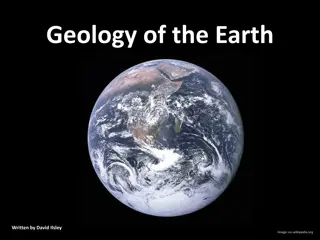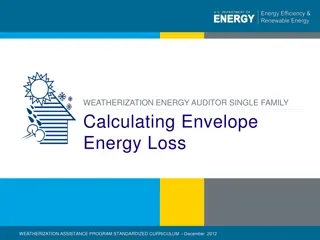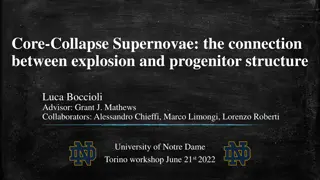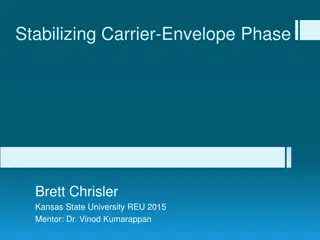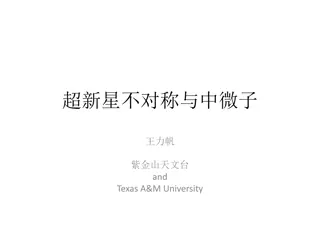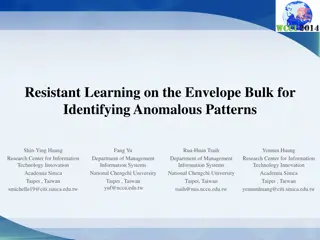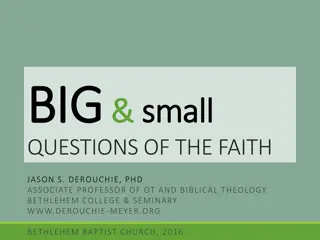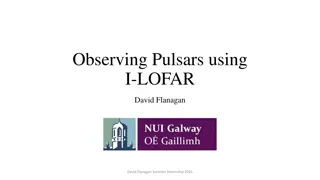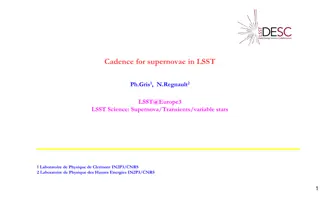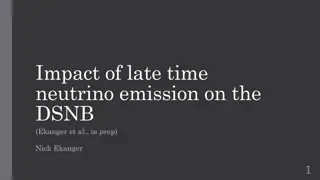Unveiling the Progenitors of Stripped Envelope Supernovae (SNe)
The mechanism behind the stripping of stripped-envelope SNe remains a key question linked to their progenitors. Various mechanisms such as Single Star Progenitors, Binary Star Progenitors, Stellar Winds, and Close Binary Interactions are thought to dominate the stripping process. Observations of Type IIb SNe progenitors reveal insights into their composition, luminosity, envelope mass, and core characteristics. Models distinguish between single and binary star progenitors based on parameters like mass, orbital period, and metallicity. The presence of helium core mass and residual hydrogen envelope mass are key factors in determining the origins of Type IIb SNe from both single and binary stars.
Download Presentation

Please find below an Image/Link to download the presentation.
The content on the website is provided AS IS for your information and personal use only. It may not be sold, licensed, or shared on other websites without obtaining consent from the author. Download presentation by click this link. If you encounter any issues during the download, it is possible that the publisher has removed the file from their server.
E N D
Presentation Transcript
STRIPPED ENVELOPE SUPERNOVAE (SNe) H He SUPERNOVA Type II Core REMOVE OUTER LAYERS H IIb He SE SNe Core SUPERNOVA Ib Core Core He Ic
THE PROGENITOR CONNECTTION What mechanism(s) drive the stripping of stripped-envelope SNe is an open question Answer is connected to what their progenitors are MECHANISMS DOMINATING STRIPPING Single Star Progenitors Binary Star Progenitors Stellar Winds Close Binary Interactions 3
FOCUS: TYPE IIb SNe Progenitor Observations Abundant Light Curves ~ 10-12% a,b,c of all core-collapse SNe Luminosity (L ) 30-40% a,b,c of all SE SNe Luminosity Hydrogen envelope mass log10(L/L ) = 4.72 5.4 Six with detected progenitors 0.01 0.5 M Only stripped envelope SN progenitor with detected binary companion Effective Temperature log10(Teff/K) = 3.58 3.8 Helium core mass 2 6 M Teff (K) H He a Shivvers et al., 2016 b Li et al., 2011 c Smith et al., 2011 Core 4 Type IIb
Models Observation SINGLE VS BINARY STAR PROGENITORS OF TYPE IIb SNe (METHOD) Type IIb H He Core 5
MODEL PARAMETER SPACE Parameter search space Single star models*: M/M = 10 80 Binary star models*: M1/M = 10 18 M2/M = 6 M1 log10(Porb /d) = 0.0 4.0 Conservative and non-conservative MT H He *solar metallicity, non-rotating Core 6 Type IIb
CAN SINGLE STARS BE TYPE IIb SN PROGENITORS? Helium core mass Models Models with residual Hydrogen envelope mass 0.01 0.5 M (candidates) Observations Sravan et al., in prep Models NO Observations H He Luminosity and Teff Core 7 Type IIb
H He CAN BINARY STARS BE TYPE IIb SN PROGENITORS? Core Type IIb Parameter space occupied by binary star models reaching core-collapse with 0.01 0.5 M residual Hydrogen envelope (candidates) Sravan et al., in prep 8
CAN BINARY STARS BE TYPE IIb SN PROGENITORS? Helium core mass Observations Models with residual Hydrogen envelope mass 0.01 0.5 M (candidates) Models Sravan et al., in prep Observations YES! Models Luminosity and Teff H He Core 9 Type IIb
SUMMARY We find solar-metallicity, non-rotating single stars cannot be Type IIb progenitors ** Solar-metallicity, non-rotating binary stars can be Type IIb progenitors ** These systems have: Mass ratios > 0.6 3.2 < log10(Porb,i) < 3.6 Companion luminosity: 4 < log10(L/L )< 4.8 Predicted rate ~ 1% of all CC SNe 10
FUTURE WORK Complete parameter space: binary star models Mprim > 20M Study light curves from IIb progenitor models 11
THANK YOU! 12




